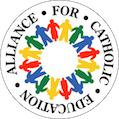The Critical Family-School Connection

Last week I had the opportunity to present to the Notre Dame Alumni Club of Charlotte. Hosted at Charlotte Catholic High School—and with a few past, current, and hopefully future Remick Leaders in attendance—the presentation focused on faith, parents, and Catholic education.
The talk draws on a qualitative analysis that colleagues and I conducted by isolating what more than thirty Church documents—dating back to 1885–had to say about parents and Catholic education (summarized in an ACE Press Publication, Entrusted in Faith, Frabutt & Rocha, 2009; see also Frabutt, Holter, Nuzzi, Rocha, & Cassel, 2010).
One of the prominent themes derived from these documents is that parents are the primary and principal educators of their children, and they best model the Christian life by being witnesses of the faith themselves. The documents build on that foundation, however, by stressing that parents do not bear this responsibility alone. In the true nature of community, they bring to fulfillment the education of their offspring via deep partnership with teachers and educators.
This summer during classes for the Remick Leadership program, at least three Remick Leaders addressed this nexus between the family and the school in one of their assignments. They emphasized that the root beliefs of parents, or the relationships between students and leaders can help students stay focused on succeeding and reaching their potential. But domestic turmoil can also engulf students, sometimes making issues of survival more pertinent than this week's chemistry homework.
We intuitively know that family and community challenges spill over into school. This is confirmed by a recent document from the American Psychological Association: The Top 20 Principles from Psychology for Teaching and Learning.
Principle 13 states that learning is situated in multiple social contexts. Basically, our individual students are situated within peer groups, families, and classrooms, which are themselves situated within schools, neighborhoods, communities, cultures, and broader society. These layers overlap and are sometimes referred to as an ecological model of child development.
The critical family-school connection, underscored both by the Church and the field of psychology, points to several actionable lessons for teachers and school leaders.
- The first speaks to our very stance toward the students in our midst: we must always be inquisitive about the “why” behind a challenging behavior, or a failure to focus, or an inability to complete homework. What may be going on beyond the school walls to account for it? Sometimes home visits are an ideal way to become more attuned to the families we serve.
- Second, be intentional about how teaching and learning in the school are connected to students’ cultural and linguistic experiences.
- Third, ensure that there are diverse and perhaps non-traditional ways for families to connect, drawing family assets into the life of the school and classroom.
This list is just a basic start, and I invite you to share other innovative ways to foster the family-school connection. Everything we’ve come to know about this important aspect of our ministry says that partnership with families is a requirement for unlocking students’ God-given potential.



